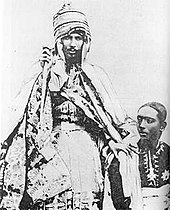This article needs additional citations for verification. (October 2012) (Learn how and when to remove this template message)
|
| Ethio-Egyptian War | |||||||
|---|---|---|---|---|---|---|---|
  Yohannes IV of Ethiopia and Isma'il Pasha of Egypt. | |||||||
| |||||||
| Belligerents | |||||||
| Commanders and leaders | |||||||
[1] Count Zichy |
| ||||||
| Strength | |||||||
| 13,000[2] | 50,000[2] – 80,000[3] | ||||||
| Casualties and losses | |||||||
| 2,000+[4] | ? | ||||||
The Ethiopian-Egyptian War was a war between the Ethiopian Empire and the Khedivate of Egypt from 1874 to 1876, resulting in an Ethiopian victory.
Background[edit]
Egypt under the rule of the Ottoman Empire, led by Isma'il Pasha, the Khedive of Egypt, sought to expand his reign to the land of Abyssinia and control the Blue Nile. Isma'il Pasha became the ruler of Egypt in 1863. After annexing Darfur in 1875, he turned his attention to Ethiopia. He wished to create an empire covering the whole of the Nile River, part of which, the Blue Nile, is located within Ethiopia, and to do this he built a large army, recruiting many European and American officers. Meanwhile, Emperor Yohannes IV became the emperor of Ethiopia in 1872 after defeating Tekle Giyorgis II in battle. He worked on modernizing his army, some of whom were trained by the British adventurer John Kirkham.
The Battle of Gundet[edit]
The Egyptians under Arakil Bey and Danish Colonel Ahrendrup invaded from their coastal possessions in what is now Eritrea. Following some skirmishes, the armies of Yohannes and Isma'il met at Gundet on the morning of 16 November 1876. Not only were the Egyptians vastly outnumbered, they were also taken completely by surprise as they were marching through a narrow mountain pass. The mass of Ethiopian warriors sallied forth from their hiding places up the slope and swiftly charged down upon the shocked Egyptian columns, nullifying the latter's advantage in firepower and causing many of the unenthusiastic fellahin soldiers to rout. The Egyptian forces were completely destroyed. News of this huge defeat was suppressed in Egypt for fear that it would undermine the government of the Khedive.
The Battle of Gura[edit]
Following the botched invasion, the Egyptians again attempted a conquest of Ethiopia, this time with an army of about 13,000 men. The forces of Isma'il Pasha, now under Ratib Pasha, arrived at Massawa on December 14, 1875. By March, they had arrived near the plain of Gura, and set up two forts, one in the Plains of Gura, and the other at the Khaya Khor mountain pass a few kilometres away. The Ethiopians, with a force of some 50-60,000 (of whom only about 15,000 could fight at one time due to battlefield layout) engaged them on the 7th of March, 1875, and Ratib ordered just over 5,000 out of 7,700 men stationed at Fort Gura to leave the fort and engage the Ethiopians. This force was quickly surrounded by the Ethiopian advance guard, probably commanded by Ras Alula, and quickly broke. The Ethiopians then fell back, and, on the 10th of March, mounted a secondary attack on Fort Gura, which was repelled. The Ethiopian force dissolved the next day, and the devastated Egyptians soon withdrew.
Aftermath[edit]
Ethiopia and Egypt remained in a state of tension, which largely abated after the 1884 Hewett Treaty. Ras Alula, however, had shown himself to be a reliable general, and was promoted by Yohannes IV to the rank of Ras, and appointed governor of the Mareb Malash.
European involvement[edit]
Several foreigners were involved in the war. These include a British adventurer John Kirkham on the Ethiopian side, and the Dane Adolph Arendrup as well as a Swiss explorer Werner Munzinger on the Egyptian side. Munzinger led one of the Egyptian attacks against Ethiopia, marching inland from Tadjoura, but his troops were overwhelmed by the army of Mahammad ibn Hanfadhe, Sultan of Aussa, and he was killed in battle.[1]
See also[edit]
- British Expedition to Abyssinia
- First Italo-Abyssinian War
- Battle of Adwa
- Second Italo-Abyssinian War
- Military history of Ethiopia
- Battle of Gura
References[edit]
- ^ a b Edward Ullendorff, The Ethiopians: An Introduction to Country and People, second edition (London: Oxford University Press, 1965), p. 90. ISBN 0-19-285061-X.
- ^ a b http://www.historynet.com/first-italo-abyssinian-war-battle-of-adowa.htm
- ^ "The Ethiopian-Egyptian War: 1874–1876". Retrieved 2016-12-21.
- ^ Jesman, Czeslaw (January 1959). "Egyptian Invasion of Ethiopia". African Affairs. Oxford University Press. 58 (230): 75–81. JSTOR 718057.

No comments:
Post a Comment